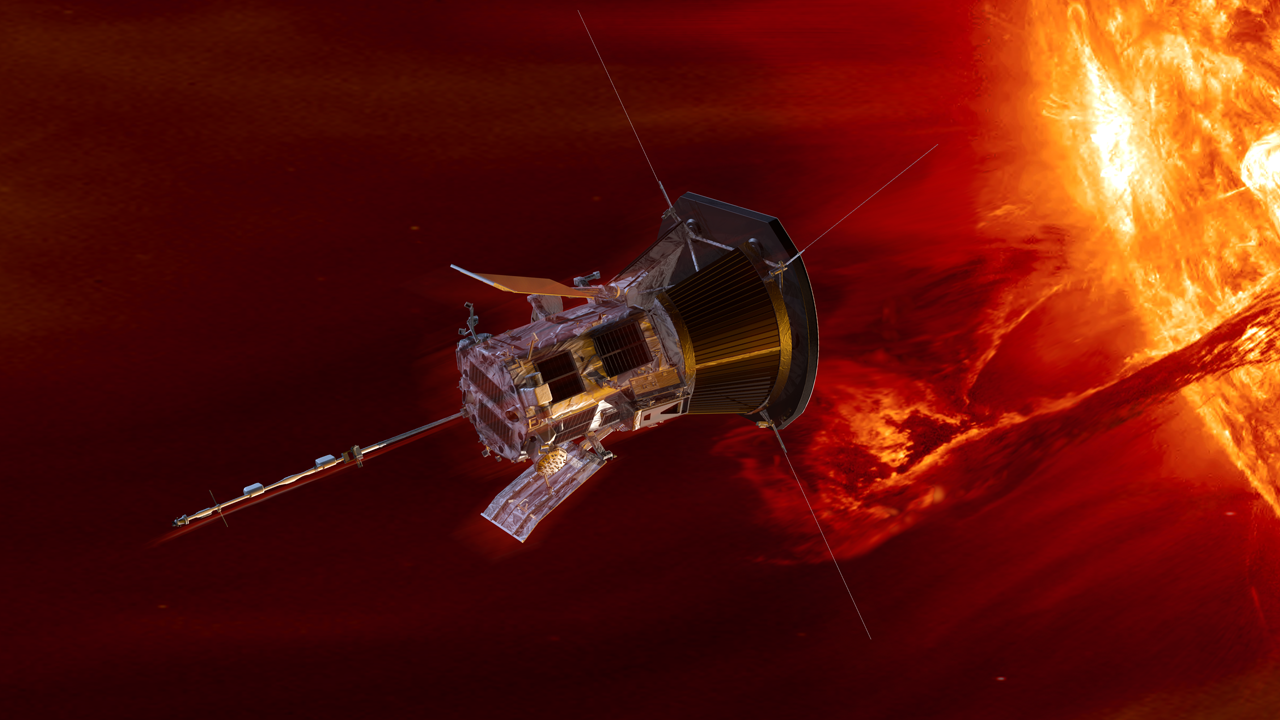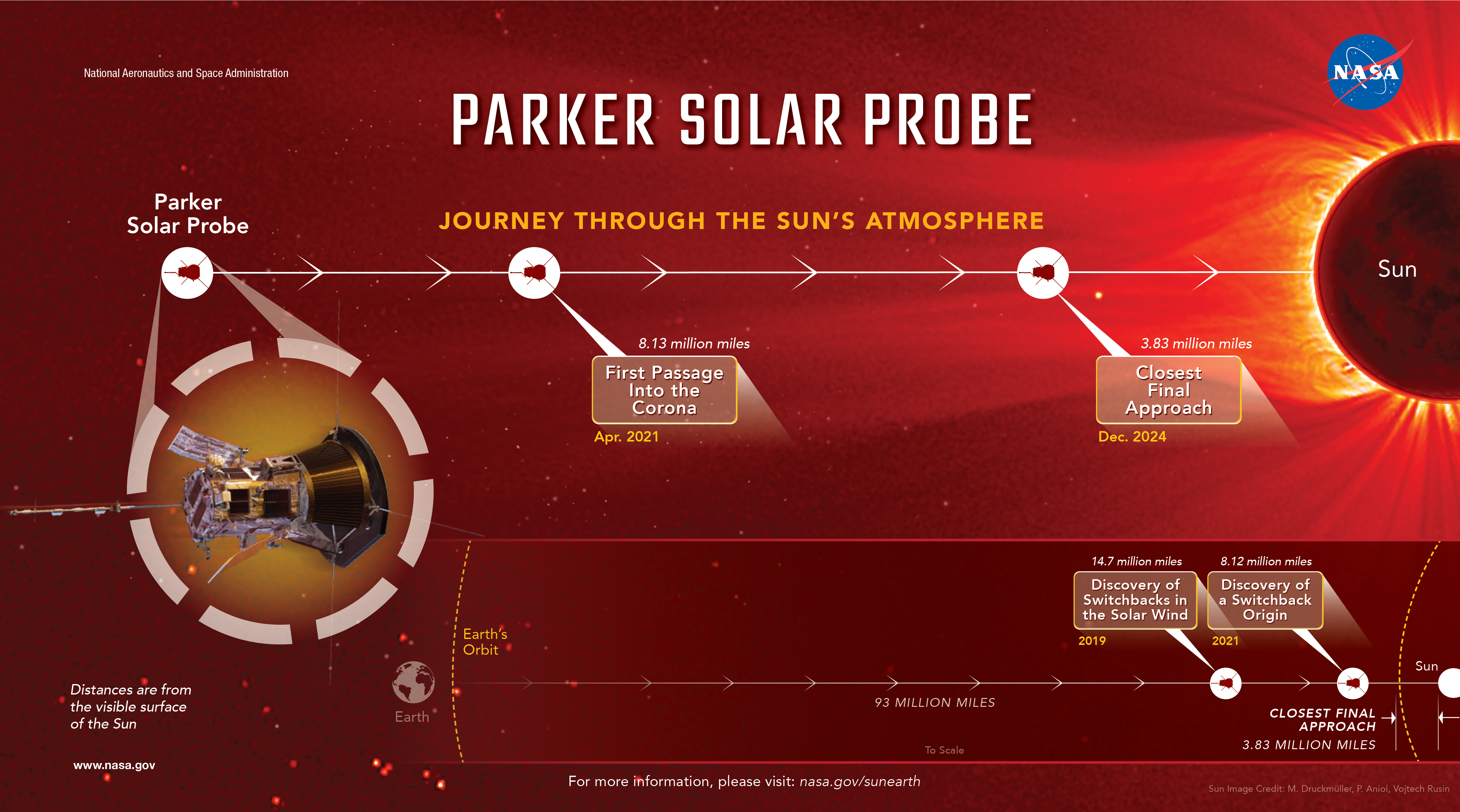NASA’s Parker Solar Probe Makes History With Closest Pass to Sun

NASA/APL
Operations teams have confirmed NASA’s mission to “touch” the Sun survived its record-breaking closest approach to the solar surface on Dec. 24, 2024.
Breaking its previous record by flying just 3.8 million miles above the surface of the Sun, NASA’s Parker Solar Probe hurtled through the solar atmosphere at a blazing 430,000 miles per hour — faster than any human-made object has ever moved. A beacon tone received late on Dec. 26 confirmed the spacecraft had made it through the encounter safely and is operating normally.
This pass, the first of more to come at this distance, allows the spacecraft to conduct unrivaled scientific measurements with the potential to change our understanding of the Sun.
Flying this close to the Sun is a historic moment in humanity’s first mission to a star.

Nicky fox
NASA Associate Administrator, Science Mission Directorate
“Flying this close to the Sun is a historic moment in humanity’s first mission to a star,” said Nicky Fox, who leads the Science Mission Directorate at NASA Headquarters in Washington. “By studying the Sun up close, we can better understand its impacts throughout our solar system, including on the technology we use daily on Earth and in space, as well as learn about the workings of stars across the universe to aid in our search for habitable worlds beyond our home planet.”
Credits: NASA
This video can be freely shared and downloaded at https://svs.gsfc.nasa.gov/14741.
Parker Solar Probe has spent the last six years setting up for this moment. Launched in 2018, the spacecraft used seven flybys of Venus to gravitationally direct it ever closer to the Sun. With its last Venus flyby on Nov. 6, 2024, the spacecraft reached its optimal orbit. This oval-shaped orbit brings the spacecraft an ideal distance from the Sun every three months — close enough to study our Sun’s mysterious processes but not too close to become overwhelmed by the Sun’s heat and damaging radiation. The spacecraft will remain in this orbit for the remainder of its primary mission.
“Parker Solar Probe is braving one of the most extreme environments in space and exceeding all expectations,” said Nour Rawafi, the project scientist for Parker Solar Probe at the Johns Hopkins Applied Physics Laboratory (APL), which designed, built, and operates the spacecraft from its campus in Laurel, Maryland. “This mission is ushering a new golden era of space exploration, bringing us closer than ever to unlocking the Sun’s deepest and most enduring mysteries.”
Close to the Sun, the spacecraft relies on a carbon foam shield to protect it from the extreme heat in the upper solar atmosphere called the corona, which can exceed 1 million degrees Fahrenheit. The shield was designed to reach temperatures of 2,600 degrees Fahrenheit — hot enough to melt steel — while keeping the instruments behind it shaded at a comfortable room temperature. In the hot but low-density corona, the spacecraft’s shield is expected to warm to 1,800 degrees Fahrenheit.

“It’s monumental to be able to get a spacecraft this close to the Sun,” said John Wirzburger, the Parker Solar Probe mission systems engineer at APL. “This is a challenge the space science community has wanted to tackle since 1958 and had spent decades advancing the technology to make it possible.”
By flying through the solar corona, Parker Solar Probe can take measurements that help scientists better understand how the region gets so hot, trace the origin of the solar wind (a constant flow of material escaping the Sun), and discover how energetic particles are accelerated to half the speed of light.
“The data is so important for the science community because it gives us another vantage point,” said Kelly Korreck, a program scientist at NASA Headquarters and heliophysicist who worked on one of the mission’s instruments. “By getting firsthand accounts of what’s happening in the solar atmosphere, Parker Solar Probe has revolutionized our understanding of the Sun.”
Previous passes have already aided scientists’ understanding of the Sun. When the spacecraft first passed into the solar atmosphere in 2021, it found the outer boundary of the corona is wrinkled with spikes and valleys, contrary to what was expected. Parker Solar Probe also pinpointed the origin of important zig-zag-shaped structures in the solar wind, called switchbacks, at the visible surface of the Sun — the photosphere.
Since that initial pass into the Sun, the spacecraft has been spending more time in the corona, where most of the critical physical processes occur.
“We now understand the solar wind and its acceleration away from the Sun,” said Adam Szabo, the Parker Solar Probe mission scientist at NASA’s Goddard Space Flight Center in Greenbelt, Maryland. “This close approach will give us more data to understand how it’s accelerated closer in.”
Parker Solar Probe has also made discoveries across the inner solar system. Observations showed how giant solar explosions called coronal mass ejections vacuum up dust as they sweep across the solar system, and other observations revealed unexpected findings about solar energetic particles. Flybys of Venus have documented the planet’s natural radio emissions from its atmosphere, as well as the first complete image of its orbital dust ring.
So far, the spacecraft has only transmitted that it’s safe, but soon it will be in a location that will allow it to downlink the data it collected on this latest solar pass.
The data that will come down from the spacecraft will be fresh information about a place that we, as humanity, have never been.

Joe Westlake
Heliophysics Division Director, NASA Headquarters
“The data that will come down from the spacecraft will be fresh information about a place that we, as humanity, have never been,” said Joe Westlake, the director of the Heliophysics Division at NASA Headquarters. “It’s an amazing accomplishment.”
The spacecraft’s next planned close solar passes come on March 22, 2025, and June 19, 2025.
By Mara Johnson-Groh
NASA’s Goddard Space Flight Center, Greenbelt, Md.
Media Contact: Sarah Frazier
Details
from NASA https://ift.tt/JpuxLye










No comments:
Post a Comment